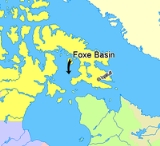
Foxe Basin
Encyclopedia
Not to be confused with Fox Bay
, Falkland Islands
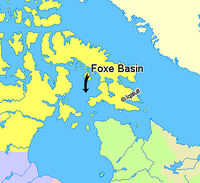
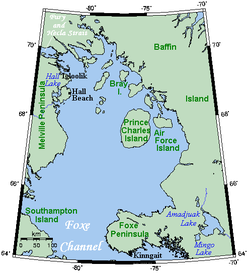 Foxe Basin is a shallow oceanic basin
Foxe Basin is a shallow oceanic basin
north of Hudson Bay
, in Nunavut
, Canada
, located between Baffin Island
and the Melville Peninsula
. For most of the year, it is blocked by ice floe
s.
The nutrient-rich cold waters found in the basin are known to be especially favorable to phytoplankton
and the numerous islands within it are important bird habitat
s, including Sabine's Gull
s and many types of shorebirds. Bowhead whale
s migrate to the northern part of the basin each summer.
The basin takes its name from the English
explorer Luke Fox
e.
currents and strong winds keep the ice pack in constant motion and contribute to the numerous polynya
s and shore lead
s which are found throughout the region. This same motion, combined with the high sediment content of the water makes the sea ice of Foxe Basin dark and rough, easily distinguishable from other ice in the Canadian Arctic
.
s are found across the southern portion of the region, where most of the seabird
s nest. Coastal marsh
es and tidal flats
up to 6.5 km (4 mi) in width are found in the vast lowland section of eastern Foxe Basin, as well as in the bays of Southampton Island
.
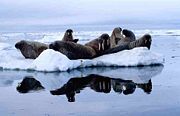
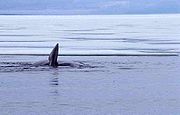 This is one of the little known areas of the Canadian Arctic
This is one of the little known areas of the Canadian Arctic
, though it is proving to be biologically rich and diverse. The numerous polynyas in northern Foxe Basin support high densities of bearded seal
s and the largest walrus
herd in Canada (over 6,000 individuals). Ringed seal
and polar bear
are common, with north Southampton Island as one of the highest-density polar bear denning areas in Canada. This area is also an important summering area for the bowhead whale
, beluga and narwhal
. Both bowhead whales and beluga winter in the waters of northeastern Hudson Bay
. The region is the main North America
n stronghold of the Sabine's gull, with some 10,000 pairs nesting here. Moderate numbers of black guillemot
s, Arctic tern
s and glaucous
, herring
and ivory
gull
s also breed here. The Great Plain of the Koukdjuak
on Baffin Island is the world's largest goose
nesting colony, with upwards of 1.5 million birds, 75 percent of which are Lesser snow geese
and the remainder Canada geese
and brant
. Shorebirds and duck
s are also abundant. Several hundred thousand thick-billed murres
breed on the cliffs of Digges Sound
and Coats Island
to the south.
Fox Bay
Fox Bay is the second largest settlement on West Falkland in the Falkland Islands. It is located on a bay of the same name, and is on the south east coast of the island...
, Falkland Islands


Oceanic basin
Hydrologically, an oceanic basin may be anywhere on Earth that is covered by seawater, but geologically ocean basins are large geologic basins that are below sea level...
north of Hudson Bay
Hudson Bay
Hudson Bay , sometimes called Hudson's Bay, is a large body of saltwater in northeastern Canada. It drains a very large area, about , that includes parts of Ontario, Quebec, Saskatchewan, Alberta, most of Manitoba, southeastern Nunavut, as well as parts of North Dakota, South Dakota, Minnesota,...
, in Nunavut
Nunavut
Nunavut is the largest and newest federal territory of Canada; it was separated officially from the Northwest Territories on April 1, 1999, via the Nunavut Act and the Nunavut Land Claims Agreement Act, though the actual boundaries had been established in 1993...
, Canada
Canada
Canada is a North American country consisting of ten provinces and three territories. Located in the northern part of the continent, it extends from the Atlantic Ocean in the east to the Pacific Ocean in the west, and northward into the Arctic Ocean...
, located between Baffin Island
Baffin Island
Baffin Island in the Canadian territory of Nunavut is the largest island in the Canadian Arctic Archipelago, the largest island in Canada and the fifth largest island in the world. Its area is and its population is about 11,000...
and the Melville Peninsula
Melville Peninsula
Melville Peninsula is a large peninsula in the Canadian Arctic. Since 1999, it has been part of Nunavut. Before that, it was part of the District of Franklin. It's separated from Southampton Island by Frozen Strait. The narrow isthmus connecting the peninsula to the mainland is styled the “Rae...
. For most of the year, it is blocked by ice floe
Sea ice
Sea ice is largely formed from seawater that freezes. Because the oceans consist of saltwater, this occurs below the freezing point of pure water, at about -1.8 °C ....
s.
The nutrient-rich cold waters found in the basin are known to be especially favorable to phytoplankton
Phytoplankton
Phytoplankton are the autotrophic component of the plankton community. The name comes from the Greek words φυτόν , meaning "plant", and πλαγκτός , meaning "wanderer" or "drifter". Most phytoplankton are too small to be individually seen with the unaided eye...
and the numerous islands within it are important bird habitat
Habitat
* Habitat , a place where a species lives and grows*Human habitat, a place where humans live, work or play** Space habitat, a space station intended as a permanent settlement...
s, including Sabine's Gull
Sabine's Gull
The Sabine's Gull is a small gull. Its generic placement is disputed; some authors treat it as the sole species in the genus Xema as Xema sabini, while others retain it in the genus Larus as Larus sabini. It breeds in the arctic and has a circumpolar distribution through northernmost North America...
s and many types of shorebirds. Bowhead whale
Bowhead Whale
The bowhead whale is a baleen whale of the right whale family Balaenidae in suborder Mysticeti. A stocky dark-colored whale without a dorsal fin, it can grow to in length. This thick-bodied species can weigh to , second only to the blue whale, although the bowhead's maximum length is less than...
s migrate to the northern part of the basin each summer.
The basin takes its name from the English
English people
The English are a nation and ethnic group native to England, who speak English. The English identity is of early mediaeval origin, when they were known in Old English as the Anglecynn. England is now a country of the United Kingdom, and the majority of English people in England are British Citizens...
explorer Luke Fox
Luke Fox
Luke Foxe was an English explorer, born in Kingston-upon-Hull, Yorkshire, who searched for the Northwest Passage across North America. In 1631, he sailed much of the western Hudson Bay before concluding no such passage was possible. Foxe Basin, Foxe Channel and Foxe Peninsula were named after him...
e.
Waterway
Foxe Basin is a broad, predominantly shallow depression, generally less than 100 metres (328.1 ft) in depth, while to the south, depths of up to 400 metres (1,312.3 ft) occur. The tidal range decreases from 5 m (16.4 ft) in the southeast to less than 1 m (3.3 ft) in the northwest. During much of the year, landfast ice dominates in the north, while pack ice prevails towards the south. Foxe Basin itself is rarely ice-free until September, open pack ice being common throughout the summer. Vigorous tidalTide
Tides are the rise and fall of sea levels caused by the combined effects of the gravitational forces exerted by the moon and the sun and the rotation of the Earth....
currents and strong winds keep the ice pack in constant motion and contribute to the numerous polynya
Polynya
A polynya or polynia is an area of open water surrounded by sea ice. It is now used as geographical term for an area of unfrozen sea within the ice pack. It is a loanword from , , which means a natural ice hole, and was adopted in the 19th century by polar explorers to describe navigable...
s and shore lead
Shore lead
A shore lead is an oceanographic term for a waterway opening between pack ice and shore. While the gap of water may be as narrow as a tide crack if closed by wind or currents, it can be as wide as . Its formation can be influenced by tidal action, or subsurface conditions, such as current and...
s which are found throughout the region. This same motion, combined with the high sediment content of the water makes the sea ice of Foxe Basin dark and rough, easily distinguishable from other ice in the Canadian Arctic
Northern Canada
Northern Canada, colloquially the North, is the vast northernmost region of Canada variously defined by geography and politics. Politically, the term refers to the three territories of Canada: Yukon, Northwest Territories, and Nunavut...
.
Coast
The terrain is rocky and rugged in the southern half of the region, and generally low-lying in the north. High cliffCliff
In geography and geology, a cliff is a significant vertical, or near vertical, rock exposure. Cliffs are formed as erosion landforms due to the processes of erosion and weathering that produce them. Cliffs are common on coasts, in mountainous areas, escarpments and along rivers. Cliffs are usually...
s are found across the southern portion of the region, where most of the seabird
Seabird
Seabirds are birds that have adapted to life within the marine environment. While seabirds vary greatly in lifestyle, behaviour and physiology, they often exhibit striking convergent evolution, as the same environmental problems and feeding niches have resulted in similar adaptations...
s nest. Coastal marsh
Marsh
In geography, a marsh, or morass, is a type of wetland that is subject to frequent or continuous flood. Typically the water is shallow and features grasses, rushes, reeds, typhas, sedges, other herbaceous plants, and moss....
es and tidal flats
Mudflat
Mudflats or mud flats, also known as tidal flats, are coastal wetlands that form when mud is deposited by tides or rivers. They are found in sheltered areas such as bays, bayous, lagoons, and estuaries. Mudflats may be viewed geologically as exposed layers of bay mud, resulting from deposition of...
up to 6.5 km (4 mi) in width are found in the vast lowland section of eastern Foxe Basin, as well as in the bays of Southampton Island
Southampton Island
Southampton Island is a large island at the entrance to Hudson Bay at Foxe Basin. One of the larger members of the Canadian Arctic Archipelago, Southampton Island is part of the Kivalliq Region in Nunavut, Canada. The area of the island is stated as by Statistics Canada . It is the 34th largest...
.
Wildlife


Arctic
The Arctic is a region located at the northern-most part of the Earth. The Arctic consists of the Arctic Ocean and parts of Canada, Russia, Greenland, the United States, Norway, Sweden, Finland, and Iceland. The Arctic region consists of a vast, ice-covered ocean, surrounded by treeless permafrost...
, though it is proving to be biologically rich and diverse. The numerous polynyas in northern Foxe Basin support high densities of bearded seal
Bearded Seal
The bearded seal , also called the square flipper seal, is a medium-sized pinniped that is found in and near to the Arctic Ocean. It gets its generic name from two Greek words that refer to its heavy jaw...
s and the largest walrus
Walrus
The walrus is a large flippered marine mammal with a discontinuous circumpolar distribution in the Arctic Ocean and sub-Arctic seas of the Northern Hemisphere. The walrus is the only living species in the Odobenidae family and Odobenus genus. It is subdivided into three subspecies: the Atlantic...
herd in Canada (over 6,000 individuals). Ringed seal
Ringed Seal
The ringed seal , also known as the jar seal and as netsik or nattiq by the Inuit, is an earless seal inhabiting the Arctic and sub-Arctic regions...
and polar bear
Polar Bear
The polar bear is a bear native largely within the Arctic Circle encompassing the Arctic Ocean, its surrounding seas and surrounding land masses. It is the world's largest land carnivore and also the largest bear, together with the omnivorous Kodiak Bear, which is approximately the same size...
are common, with north Southampton Island as one of the highest-density polar bear denning areas in Canada. This area is also an important summering area for the bowhead whale
Bowhead Whale
The bowhead whale is a baleen whale of the right whale family Balaenidae in suborder Mysticeti. A stocky dark-colored whale without a dorsal fin, it can grow to in length. This thick-bodied species can weigh to , second only to the blue whale, although the bowhead's maximum length is less than...
, beluga and narwhal
Narwhal
The narwhal, Monodon monoceros, is a medium-sized toothed whale that lives year-round in the Arctic. One of two living species of whale in the Monodontidae family, along with the beluga whale, the narwhal males are distinguished by a characteristic long, straight, helical tusk extending from their...
. Both bowhead whales and beluga winter in the waters of northeastern Hudson Bay
Hudson Bay
Hudson Bay , sometimes called Hudson's Bay, is a large body of saltwater in northeastern Canada. It drains a very large area, about , that includes parts of Ontario, Quebec, Saskatchewan, Alberta, most of Manitoba, southeastern Nunavut, as well as parts of North Dakota, South Dakota, Minnesota,...
. The region is the main North America
North America
North America is a continent wholly within the Northern Hemisphere and almost wholly within the Western Hemisphere. It is also considered a northern subcontinent of the Americas...
n stronghold of the Sabine's gull, with some 10,000 pairs nesting here. Moderate numbers of black guillemot
Black Guillemot
The Black Guillemot or Tystie is a medium-sized alcid.Adult birds have black bodies with a white wing patch, a thin dark bill, and red legs and feet. They show white wing linings in flight. In winter, the upperparts are pale grey and the underparts are white. The wings remain black with the large...
s, Arctic tern
Arctic Tern
The Arctic Tern is a seabird of the tern family Sternidae. This bird has a circumpolar breeding distribution covering the Arctic and sub-Arctic regions of Europe, Asia, and North America...
s and glaucous
Glaucous Gull
The Glaucous Gull is a large gull which breeds in the Arctic regions of the northern hemisphere and the Atlantic coasts of Europe. It is migratory, wintering from in the North Atlantic and North Pacific oceans as far south as the British Isles and northernmost states of the USA, also on the Great...
, herring
American Herring Gull
The American Herring Gull or Smithsonian Gull is a large gull which breeds in North America. It is often treated as a subspecies of the European Herring Gull but is now regarded as a separate species by some authorities.Adults are white with gray back and wings, black wingtips with white spots,...
and ivory
Ivory Gull
The Ivory Gull Pagophila eburnea is a small gull, the only species in its genus. It breeds in the high arctic and has a circumpolar distribution through Greenland, northernmost North America, and Eurasia.-Taxonomy:...
gull
Gull
Gulls are birds in the family Laridae. They are most closely related to the terns and only distantly related to auks, skimmers, and more distantly to the waders...
s also breed here. The Great Plain of the Koukdjuak
Great Plain of the Koukdjuak
The Great Plain of the Koukdjuak is located in Qikiqtaaluk Region, Nunavut within the Canadian Arctic. It is the namesake of the Koukdjuak River in western Baffin Island on the southeastern coast of Foxe Basin. It stretches from Cory Bay to Hantzsch Bay, and then inland.-Geography:The plain is...
on Baffin Island is the world's largest goose
Goose
The word goose is the English name for a group of waterfowl, belonging to the family Anatidae. This family also includes swans, most of which are larger than true geese, and ducks, which are smaller....
nesting colony, with upwards of 1.5 million birds, 75 percent of which are Lesser snow geese
Snow Goose
The Snow Goose , also known as the Blue Goose, is a North American species of goose. Its name derives from the typically white plumage. The genus of this bird is disputed...
and the remainder Canada geese
Canada Goose
The Canada Goose is a wild goose belonging to the genus Branta, which is native to arctic and temperate regions of North America, having a black head and neck, white patches on the face, and a brownish-gray body....
and brant
Brent Goose
The Brant or Brent Goose, Branta bernicla, is a species of goose of the genus Branta. The Black Brant is an American subspecies. The specific descriptor bernicla is from the same source as "barnacle" in Barnacle Goose, which looks similar but is not a close relation.-Appearance:The Brant Goose is...
. Shorebirds and duck
Duck
Duck is the common name for a large number of species in the Anatidae family of birds, which also includes swans and geese. The ducks are divided among several subfamilies in the Anatidae family; they do not represent a monophyletic group but a form taxon, since swans and geese are not considered...
s are also abundant. Several hundred thousand thick-billed murres
Brünnich's Guillemot
The Thick-billed Murre or Brünnich's Guillemot is a bird in the auk family . This bird is named after the Danish zoologist Morten Thrane Brünnich...
breed on the cliffs of Digges Sound
Digges Sound
Digges Sound is a Canadian Arctic waterway in Qikiqtaaluk, Nunavut, Canada. The sound is located at the juncture where the Hudson Strait meets northeastern Hudson Bay close to the northern tip of the Ungava Peninsula, between Digges Islands and Cape Wolstenholme...
and Coats Island
Coats Island
Coats Island lies at the northern end of Hudson Bay in the Kivalliq Region of Nunavut. At in size, it is the 107th largest island in the world, and Canada's 24th largest island....
to the south.

